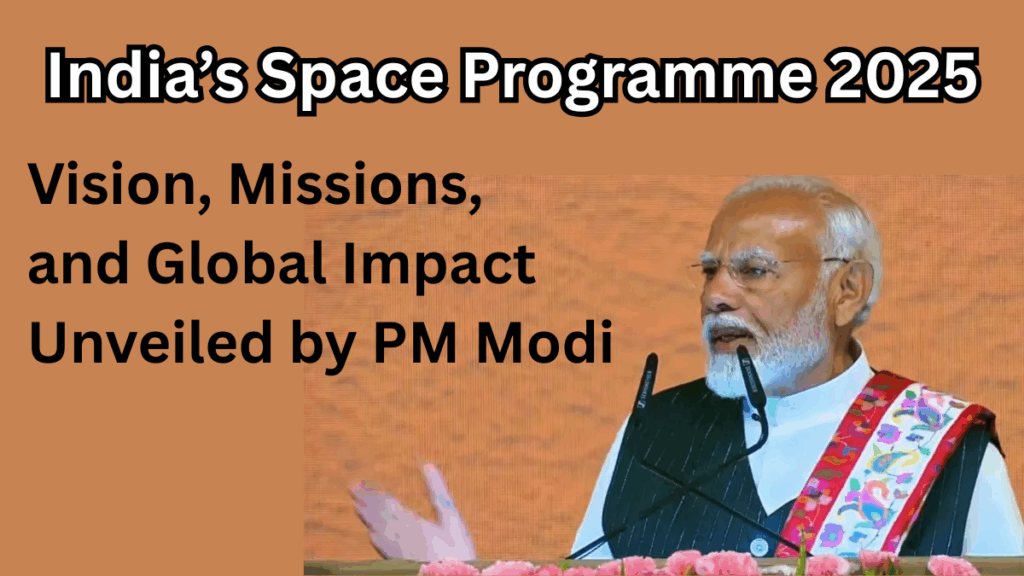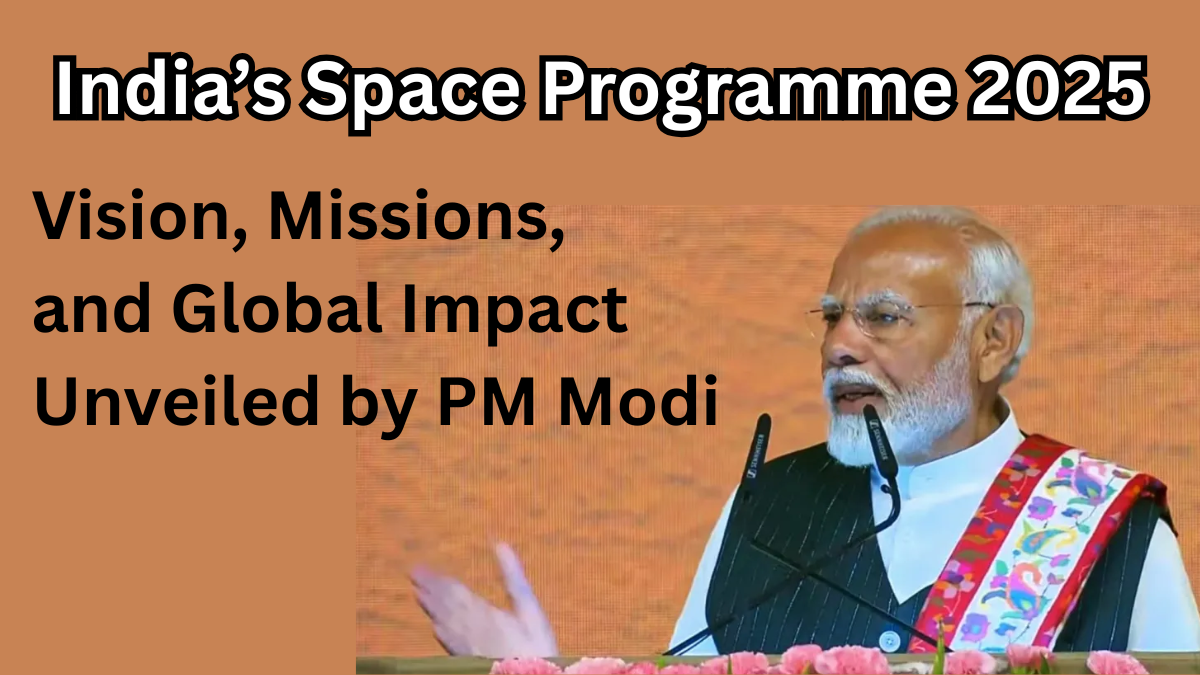India’s space programme is no longer just a matter of launching rockets or exploring the Moon and Mars. It has evolved into a vital component of the country’s socioeconomic growth and global standing. Speaking through a pre-recorded message at the Global Space Exploration Conference 2025, Prime Minister Narendra Modi emphasized this very spirit.
Held in New Delhi from May 7 to 9, the conference attracted space scientists, policymakers, and innovators from around the globe. Modi’s message, delivered amid rising geopolitical tensions, deliberately stayed focused on India’s peaceful and empowering vision for space science.

India’s Vision: Exploration with a Purpose
According to Prime Minister Modi, India’s interest in space is deeply people-centric. It’s not just about sending satellites into orbit; it’s about solving real-world problems and improving the quality of life for all citizens.
In his words,
“For India, space is about exploration as well as empowerment. It empowers governance, enhances livelihoods, and inspires generations.”
Space applications in India serve multiple public needs. From fishermen in coastal areas to farmers in the countryside, millions of Indians benefit from satellite-powered services every day.
Practical Uses of Space Technology in India
-
Weather Forecasting: Satellites help predict monsoons and cyclones, enabling timely alerts and farming decisions.
-
Fisherman Safety Alerts: Real-time warnings guide fishing boats away from storm-prone areas, saving lives.
-
Gati Shakti Infrastructure Platform: Satellite data supports the government’s integrated infrastructure initiatives by improving logistical planning.
-
Railway and Road Safety: Surveillance and GPS-based monitoring ensure safer travel.
| Application Area | Satellite-Based Impact |
|---|---|
| Fisherman Safety | Early storm alerts reduce marine casualties |
| Infrastructure Planning | Data-driven road and rail development |
| Agricultural Support | Weather updates help improve crop yield |
| Urban Management | Satellite imagery aids in city planning and waste control |
A Remarkable Journey from 1963 to the Moon’s South Pole
The Prime Minister reminded delegates of the humble beginnings of India’s space journey. Starting in 1963 with a modest rocket launch from a church in Thumba, Kerala, India has since scaled heights that few imagined possible.
Today, India is known for launching successful missions on tight budgets, breaking stereotypes and inspiring the world with its unique blend of ambition and frugality.
“Our rockets carry more than just payloads—they carry the dreams of 1.4 billion Indians.”
Timeline of India’s Space Achievements
| Year | Achievement |
|---|---|
| 1963 | First rocket launch from Thumba |
| 2008 | Chandrayaan-1 discovers water on the Moon |
| 2014 | Mangalyaan (Mars Orbiter Mission) succeeds on its first attempt |
| 2017 | Launched 104 satellites in one mission—a world record |
| 2023 | Chandrayaan-3 lands near the Moon’s South Pole |
| 2024 | Successful satellite docking in space—major milestone in space operations |
| 2025 | Joint ISRO-NASA mission to the International Space Station (ISS) |
A Global Vision: From South Asia to the Global South
India’s space agenda is increasingly global in outlook. Modi stated that India’s achievements are not merely for national pride, but also meant to uplift other developing countries through cooperation and shared technology.
“We launched a satellite for South Asian nations. Now, the G20 satellite mission will be a gift to the Global South.”
India has already launched satellites for more than 30 countries, proving itself as a dependable partner in space services. This willingness to share technology makes India’s space programme stand out on the global stage.
Global Contributions of ISRO
-
South Asia Satellite: Provided communication services to neighboring countries.
-
G20 Satellite Mission: Proposed to support countries in the Global South with climate data, agriculture monitoring, and disaster alerts.
-
Satellite Launch Services: India has launched more than 400 satellites for 34 different countries using its reliable launch vehicles.
| Initiative | Purpose |
|---|---|
| South Asia Satellite | Regional communication and cooperation |
| G20 Satellite Mission | Shared resources for environmental monitoring |
| Global Satellite Launches | Commercial and diplomatic partnerships with foreign nations |
The Road Ahead: Startups, Human Spaceflight, and Beyond
A standout point in Modi’s speech was his emphasis on how India is fostering a new ecosystem of innovation in the private sector. With over 250 space startups, India’s space sector is no longer just government-led—it’s becoming a vibrant, entrepreneurial community.
Moreover, many of India’s recent space missions have seen substantial participation by women scientists, making it a symbol of inclusion and equal opportunity in high-tech domains.
Key Developments and Future Missions
-
Gaganyaan: India’s first indigenous human spaceflight mission is under preparation.
-
ISRO-NASA Astronaut Mission: A major milestone in Indo-US cooperation, this mission will send an Indian astronaut to the International Space Station.
-
Bharatiya Antariksh Station: India’s own space station, planned for launch by 2035.
-
Moon, Mars, and Venus Missions: Targeted explorations to push India’s planetary science efforts further by 2040.
| Future Mission | Target Timeline |
|---|---|
| Gaganyaan (Human Spaceflight) | 2025 |
| Indian Astronaut on ISS | 2025 |
| Bharatiya Antariksh Station | By 2035 |
| Indian Lunar Landing | By 2040 |
| Mars and Venus Exploration | Post-2040 |
The Message at Heart: Science for Society, Not Superiority
In closing, Modi reiterated that India’s space aspirations are not rooted in a desire to dominate but to collaborate and uplift. India’s approach to space is deeply philosophical—it sees science as a tool for social justice, for shared progress, and for peaceful exploration.
“We strive not just for our own growth but to enrich global knowledge, address common challenges, and inspire future generations.”
Frequently Asked Questions (FAQs)
1. Why is India investing heavily in space when it has other pressing challenges?
India’s space investments lead to direct benefits in weather prediction, agriculture, communication, and disaster management. These technologies improve governance and support millions of citizens, making space exploration a tool for inclusive development.
2. What is the significance of the G20 Satellite Mission?
The G20 Satellite Mission, announced during India’s G20 presidency, aims to support nations of the Global South by providing free access to critical satellite data related to climate change, agriculture, disaster forecasting, and sustainable development.
3. How is the private sector contributing to India’s space programme?
More than 250 startups are now engaged in satellite manufacturing, propulsion systems, imaging technology, and analytics. These startups are making space technology more accessible and advancing India’s capabilities in aerospace innovation.
4. What is the Gaganyaan mission, and when will it launch?
Gaganyaan is India’s first human spaceflight mission. It will send Indian astronauts into low Earth orbit and is expected to launch in 2025. It marks a significant milestone in India’s goal to become self-reliant in human space exploration.
Click here to learn more
Pari is a passionate writer known for captivating stories that blend imagination and reality. Inspired by travel, history, and everyday moments, Pari crafts narratives that resonate deeply with readers.
